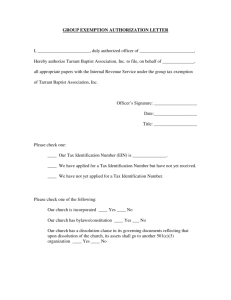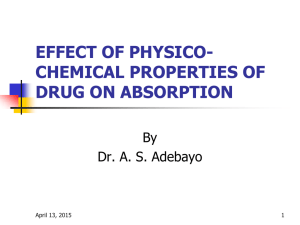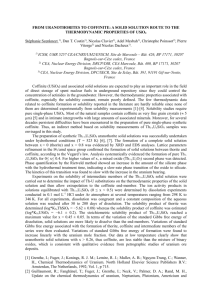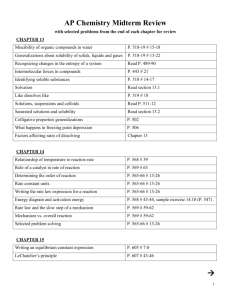Bioavailability - physicochemical and dosage form factors
advertisement
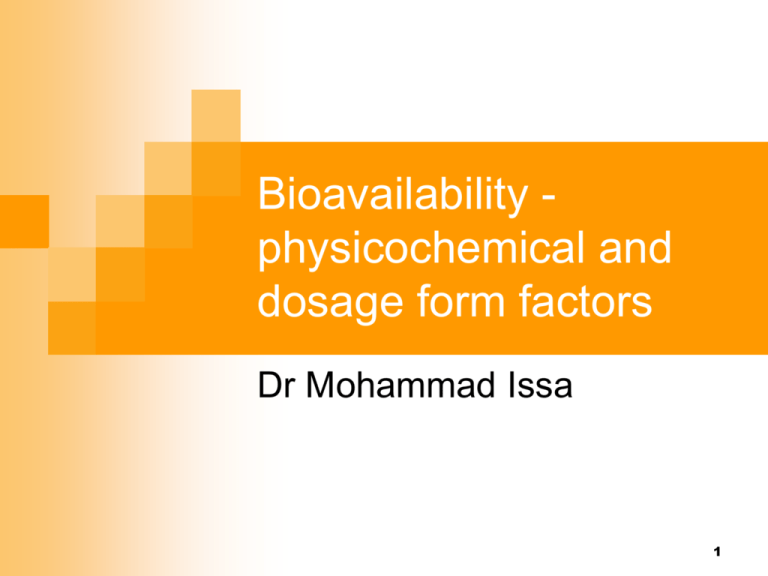
Bioavailability physicochemical and dosage form factors Dr Mohammad Issa 1 Absorption of drugs from solid dosage forms Dissolution Solid drug Absorption Drug in blood Two cases: Drug in solution Permeability controlled Dissolution rate controlled Whenever a drug is absorbed from solution dosage form faster than from solid dosage forms, it is likely that absorption is rate-limited by dissolution 2 Physicochemical factors influencing bioavailability Factors affecting dissolution and solubility 1. Factors affecting dissolution rate a) I. II. Physiological factors affecting the dissolution rate Drug factors affecting dissolution rate Factors affecting the conc of drug in solution in the GI fluids b) i. ii. iii. iv. Complexation Micellar solubilization Adsorption Chemical stability of the drug in the gastrointestinal fluids Factors affecting drug absorption 2. a) b) c) pH-partition hypothesis of drug absorption Lipid solubility Molecular size and hydrogen bonding 3 Physicochemical factors influencing bioavailability Factors affecting dissolution and solubility 1. Factors affecting dissolution rate a) I. II. Physiological factors affecting the dissolution rate Drug factors affecting dissolution rate Factors affecting the conc of drug in solution in the GI fluids b) i. ii. iii. iv. Complexation Micellar solubilization Adsorption Chemical stability of the drug in the gastrointestinal fluids Factors affecting drug absorption 2. a) b) c) pH-partition hypothesis of drug absorption Lipid solubility Molecular size and hydrogen bonding 4 Factors affecting dissolution and solubility Solid drugs need to dissolve before they can be absorbed. The dissolution of drugs can be described by the Noyes-Whitney equation. This equation, first proposed in 1897, describes the rate of dissolution of spherical particles when the dissolution process is diffusion controlled and involves no chemical reaction 5 Factors affecting dissolution and solubility: Noyes-Whitney equation dC D A(CS C ) dt h Cs C Diffusion layer dC/dt: the rate of dissolution of the drug particles D: the diffusion coefficient of the drug in solution in the gastrointestinal fluids A: the effective surface area of the drug particles in contact with the gastrointestinal fluids h: the thickness of the diffusion layer around each drug particle Cs: the saturation solubility of the drug in solution in the diffusion layer C: the concentration of the drug in the gastrointestinal fluids 6 Factors affecting dissolution and solubility: Noyes-Whitney equation Noyes Whitney equation states that the rate of dissolution is directly proportional to the surface area of the solute particle, diffusion coefficient and the concentration of solute particles present at the boundary layer. Simply put, the higher the value of the diffusion coefficient, the greater the surface area and the more concentrated the solute particles at the boundary layers are, the higher the rate of dissolution On the other hand, according to the equation the height of the boundary layer is indirectly proportional to the rate of dissolution, so the lower the height the faster the rate of dissolution. 7 Physicochemical factors influencing bioavailability Factors affecting dissolution and solubility 1. Factors affecting dissolution rate a) I. II. Physiological factors affecting the dissolution rate Drug factors affecting dissolution rate Factors affecting the conc of drug in solution in the GI fluids b) i. ii. iii. iv. Complexation Micellar solubilization Adsorption Chemical stability of the drug in the gastrointestinal fluids Factors affecting drug absorption 2. Drug dissociation and lipid solubility a) i. ii. iii. pH-partition hypothesis of drug absorption Lipid solubility Molecular size and hydrogen bonding 8 Physiological factors affecting the dissolution rate The presence of food in the gastrointestinal tract may cause a decrease in dissolution rate of a drug. The presence of food increases the viscosity of the GI fluids that might result in a reduced diffusion coefficient Surfactants in gastric juice and bile salts will affect both the wettability of the drug, and hence the effective surface area, exposed to gastrointestinal fluids, and the solubility of the drug in the gastrointestinal fluids via micellization The thickness of the diffusion layer, will be influenced by the degree of agitation experienced by each drug particle in the gastrointestinal tract. Hence an increase in gastric and/or intestinal motility may increase the dissolution rate of a sparingly soluble drug by decreasing the thickness of the diffusion layer around each drug particle 9 Physiological factors affecting the dissolution rate of drugs The concentration of drug in solution in the bulk of the gastrointestinal fluids will be influenced by such factors as the rate of removal of dissolved drug by absorption through the gastrointestinal- blood barrier, and by the volume of fluid available for dissolution, which will be dependent on the position of the drug in the gastrointestinal tract and the timing with respect to meal intake. In the stomach the volume of fluid will be influenced by the intake of fluid in the diet. 10 Physicochemical factors influencing bioavailability Factors affecting dissolution and solubility 1. Factors affecting dissolution rate a) I. II. Physiological factors affecting the dissolution rate Drug factors affecting dissolution rate Factors affecting the conc of drug in solution in the GI fluids b) i. ii. iii. iv. Complexation Micellar solubilization Adsorption Chemical stability of the drug in the gastrointestinal fluids Factors affecting drug absorption 2. Drug dissociation and lipid solubility a) i. ii. iii. pH-partition hypothesis of drug absorption Lipid solubility Molecular size and hydrogen bonding 11 Drug factors affecting dissolution rate Surface area and particle size Crystal form Solubility in the diffusion layer Salt 12 Surface area and particle size According to Noyes-Whitney equation, an increase in the total surface area of drug in contact with the gastrointestinal fluids will cause an increase in dissolution rate Provided that each particle of drug is intimately wetted by the gastrointestinal fluids, the effective surface area exhibited by the drug will be inversely proportional to the particle size of the drug Hence the smaller the particle size, the greater the effective surface area exhibited by a given mass of drug, and the higher the dissolution rate Particle size reduction is thus likely to result in increased bioavailability, provided the absorption of the drug is dissolutionrate limited. 13 Surface area and particle size One of the classic examples of particle size effects on the bioavailability of poorly soluble compounds is that of griseofulvin, where a reduction of particle size from about 10 µm to 2.7 µm was shown to produce approximately double the amount of drug absorbed in humans 14 Surface area and particle size For some drugs, particularly those that are hydrophobic in nature, micronization and other dry particle size-reduction techniques can result in aggregation of the material, with a consequent reduction in the effective surface area exposed to the gastrointestinal fluids and hence their dissolution rate and bioavailability Aspirin, phenacetin and phenobarbitone are all prone to aggregation during particle size reduction; one approach that may overcome this problem is to micronize or mill the drug with a wetting agent or hydrophilic carrier 15 Crystal form 16 Solvate: Ampicillin trihydrate 17 Crystal form Variation in the crystalline form include: Polymorphism: the arrangement of a drug substance in various crystal forms or polymorphs Amorphous solids: noncrystalline forms Solvates: forms that contain a solvent (solvate) or water (hydrate) 18 Polymorphism Polymorphs have the same chemical structure but different physical properties, such as solubility, density, hardness, and compression characteristics Some polymorphic crystals have much lower aqueous solubility than the amorphous forms, causing a product to be incompletely absorbed 19 Polymorphism: example Chloramphenicol exists in three crystalline forms designated A, B and C. At normal temperature and pressure A is the stable polymorph, B is the metastable polymorph and C is the unstable polymorph Polymorph C is too unstable to be included in a dosage form, but polymorph B, the metastable form, is sufficiently stable. 20 Polymorphism: example Chloramphenicol concentration in the body was found to be dependent on the percent of B-polymorph in the suspension. The B form is more soluble and better absorbed (see Figure) 21 Comparison of mean blood serum levels obtained with chloramphenicol palmitate suspensions containing varying ratios of A and B polymorphs, following single oral dose equivalent to 1.5 g chloramphenicol. ( Percentage polymorph B in the suspension ) 22 Amorphous solids Because the amorphous form usually dissolves more rapidly than the corresponding crystalline form(s), the possibility exists that there will be significant differences in the bioavailabilities exhibited by the amorphous and crystalline forms of drugs that show dissolution rate limited bioavailability 23 Amorphous solids: example A classic example of the influence of amorphous versus crystalline forms of a drug on its gastrointestinal bioavailability is provided by that of the antibiotic novobiocin. The more soluble and rapidly dissolving amorphous form of novobiocin was readily absorbed following oral administration of an aqueous suspension to humans and dogs. However, the less soluble and slower-dissolving crystalline form of novobiocin was not absorbed to any significant extent. The crystalline form was thus therapeutically ineffective. 24 Amorphous solids: example A further important observation was made in the case of aqueous suspensions of novobiocin. The amorphous form of novobiocin slowly converts to the more thermodynamically stable crystalline form, with an accompanying loss of therapeutic effectiveness. Thus unless adequate precautions are taken to ensure the stability of the less stable, more therapeutically effective amorphous form of a drug in a dosage form, then unacceptable variations in therapeutic effectiveness may occur. 25 Solvates Another variation in the crystalline form of a drug can occur if the drug is able to associate with solvent molecules to produce crystalline forms known as solvates When water is the solvent, the solvate formed is called a hydrate Generally the greater the solvation of the crystal, the lower are the solubility and dissolution rate in a solvent identical to the solvation molecules As the solvated and nonsolvated forms usually exhibit differences in dissolution rates, they may also exhibit differences in bioavailability, particularly in the case of poorly soluble drugs that exhibit dissolution-rate limited bioavailability 26 Solvates: example The faster-dissolving anhydrous form of ampicillin was absorbed to a greater extent from both hard gelatin capsules and an aqueous suspension than was the slowerdissolving trihydrate form 27 Solvates: example Chloroform solvate of griseofulvin has improved gastrointestinal absorption characteristics over the anhydrous form of griseofulvin 28 29 Solubility in the diffusion layer The dissolution rate of a drug under sink conditions, according to the NoyesWhitney equation, is directly proportional to its intrinsic solubility in the diffusion layer surrounding each dissolving drug particle 30 Solubility in the diffusion layer Noyes-Whitney equation dC D A(CS C ) dt h where dC/dt is the rate of dissolution of the drug particles, D is the diffusion coefficient of the drug in solution in the gastrointestinal fluids, A is the effective surface area of the drug particles in contact with the gastrointestinal fluids, h is the thickness of the diffusion layer around each drug particle, Cs is the saturation solubility of the drug in solution in the diffusion layer and C is the concentration of the drug in the gastrointestinal fluids. 31 Solubility in the diffusion layer Schematic 32 Solubility in the diffusion layer The aqueous solubility of weak electrolytes is dependent on pH Hence in the case of an orally administered solid dosage form containing a weak electrolyte drug, the dissolution rate of the drug will be influenced by its solubility and the pH in the diffusion layer surrounding each dissolving drug particle 33 Solubility in the diffusion layer The pH in the diffusion layer - the microclimate pH - for a weak electrolyte will be affected by the pKa and solubility of the dissolving drug and the pKa and solubility of the buffers in the bulk gastrointestinal fluids Thus differences in dissolution rate will be expected in different regions of the gastrointestinal tract 34 Solubility in the diffusion layer The solubility of weakly acidic drugs increases with pH, and so as a drug moves down the gastrointestinal tract from the stomach to the intestine, its solubility will increase. Conversely, the solubility of weak bases decreases with increasing pH, i.e. as the drug moves down the gastrointestinal tract. 35 Solubility in the diffusion layer Examples Case 1: The antifungal drug ketoconazole, a weak base, is particularly sensitive to gastric pH. Dosing ketoconazole 2 hours after the administration of the H2 blocker cimetidine, which reduces gastric acid secretion, results in a significantly reduced rate and extent of absorption Case 2: Similarly, in the case of the antiplatelet dipyrimidole, pretreatment with the H2 blocker famotidine reduces the peak plasma concentration by a factor of up to 10 36 Salts The dissolution rate of a weakly acidic drug in gastric fluid (pH 1-3.5) will be relatively low If the pH in the diffusion layer could be increased, then the solubility, Cs, exhibited by the acidic drug in this layer, and hence its dissolution rate in gastric fluids, would be increased even though the bulk pH of gastric fluids remained at the same low value The pH of the diffusion layer would be increased if the chemical nature of the weakly acidic drug were changed from that of the free acid to a basic salt (e.g. the sodium or potassium form of the free acid) The pH of the diffusion layer surrounding each particle of the salt form would be higher (e.g. 5-6) than the low bulk pH (1-3.5) of the gastric fluids because of the neutralizing action of the strong anions (Na+ or K+) ions present in the diffusion layer 37 the dissolution process of a salt form of a weakly acidic drug in gastric fluid Diffusion layer Gastric fluid (pH 5-6) (pH 1-3) Na+ A- Na+ ANaA Na+ A- ANa+ Redissolution Drug HAdissolved Blood diffusion Na+ A Fine precipitate of the free acid (HA) NaA: sodium salt of acidic drug Absorption 38 Salts The oral administration of a solid dosage form containing a strong basic salt of a weakly acidic drug would be expected to give a more rapid rate of drug dissolution and (in the case of drugs exhibiting dissolution rate limited absorption) a more rapid rate of drug absorption than the free acid form of the drug 39 Salts: example The non-steroidal anti-inflammatory drug naproxen was originally marketed as the free acid for the treatment of rheumatoid and osteoarthritis. However, the sodium salt (naproxen sodium) is absorbed faster and is more effective in newer indications, such as mild to moderate pain 40 Salts Although salt forms are often selected to improve bioavailability, other factors, such as chemical stability, hygroscopicity, manufacturability and crystallinity, will all be considered during salt selection and may preclude the choice of a particular salt The sodium salt of aspirin, sodium acetylsalicylate, is much more prone to hydrolysis than is aspirin, acetylsalicylic acid, itself 41 Salts One way to overcome chemical instabilities or other undesirable features of salts is to form the salt in situ or to add basic/acidic excipients to the formulation of a weakly acidic or weakly basic drug The presence of the basic excipients in the formulation of acidic drugs ensures that a relatively basic diffusion layer is formed around each dissolving particle (such as buffered aspirin: aspirin mixed with small amounts of magnesium carbonate and aluminum dihydroxyaminoacetate) 42 Physicochemical factors influencing bioavailability Factors affecting dissolution and solubility 1. Factors affecting dissolution rate a) I. II. Physiological factors affecting the dissolution rate Drug factors affecting dissolution rate Factors affecting the conc of drug in solution in the GI fluids b) i. ii. iii. iv. Complexation Micellar solubilization Adsorption Chemical stability of the drug in the gastrointestinal fluids Factors affecting drug absorption 2. Drug dissociation and lipid solubility a) i. ii. iii. pH-partition hypothesis of drug absorption Lipid solubility Molecular size and hydrogen bonding 43 Factors affecting the conc of drug in solution in the GI fluids Complexation Micellar solubilization Adsorption Chemical stability 44 Complexation Complexation of a drug may occur within the dosage form and/or in the gastrointestinal fluids, and can be beneficial or detrimental to absorption Complexation may occur between the drug and: 1. 2. 3. Component of gastrointestinal fluids Dietary components Excipients within the dosage forms 45 Complexation with component of gastrointestinal fluids Mucin, a normal component of gastrointestinal fluids, complexes with some drugs. The antibiotic streptomycin binds to mucin, thereby reducing the available concentration of the drug for absorption. It is thought that this may contribute to its poor bioavailability. 46 Complexation with dietary components In general this only becomes an issue (with respect to bioavailability) where an irreversible or an insoluble complex is formed. In such cases the fraction of the administered dose that becomes complexed is unavailable for absorption. However, if the complex formed is water soluble and readily dissociates to liberate the 'free' drug, then there may be little effect on drug absorption. 47 Complexation with dietary components Tetracycline, for example, forms nonabsorbable complexes with calcium and iron, and thus it is advised that patients do not take products containing calcium or iron, such as milk, iron preparations or indigestion remedies, at the same time of day as the tetracycline. 48 Complexation with excipients within the dosage forms Examples of drug-excepient complexes that reduce drug bioavailability are those between amphetamine and sodium carboxymethylcellulose, and between phenobarbitone and polyethylene glycol 4000 Complexation between drugs and excipients probably occurs quite often in liquid dosage forms. 49 Complexation to increase drug solubility Complexation is sometimes used to increase drug solubility, particularly of poorly watersoluble drugs. One class of complexing agents that is increasingly being employed to increase drug solubility is the cyclodextrin family 50 Cyclodextrins Cyclodextrins are enzymatically modified starches They are composed of glucopyranose units which form a ring of either six (α-cyclodextrin), seven (β -cyclodextrin) or eight (γ -cyclodextrin) units The outer surface of the ring is hydrophilic and the inner cavity is hydrophobic 51 Cyclodextrins Lipophilic molecules can fit into the ring to form soluble inclusion complexes The ring of β-cyclodextrin is the correct size for the majority of drug molecules, and normally one drug molecule will associate with one cyclodextrin molecule to form reversible complexes 52 Hydrophobic cavity Hydrophilic exterior ` + Free Cyclodextrin Hydrophobic drug: poor solubility Cyclodextrin-drug complex: Improved solubility 53 Cyclodextrins The antifungal miconazole shows poor oral bioavailability owing to its poor solubility. In the presence of cyclodextrin the solubility and dissolution rate of miconazole are significantly enhanced (by up to 55- and 255fold, respectively) This enhancement of dissolution rate resulted in a more than doubling of the oral bioavailability in a study in rats 54 Micellar solubilization Micellar solubilization can also increase the solubility of drugs in the gastrointestinal tract The ability of bile salts to solubilize drugs depends mainly on the lipophilicity of the drug 55 Adsorption The concurrent administration of drugs and medicines containing solid adsorbents (e.g. antidiarrhoeal mixtures) may result in the adsorbents interfering with the absorption of drugs from the gastrointestinal tract The adsorption of a drug on to solid adsorbents such as kaolin or charcoal may reduce its rate and/or extent of absorption, owing to a decrease in the effective concentration of the drug in solution available for absorption 56 Adsorption Examples of drug-adsorbent interactions that give reduced extents of absorption are promazine-charcoal and linomycin-kaopectate. Talc, which can be included in tablets as a glidant, is claimed to interfere with the absorption of cyanocobalamin by virtue of its ability to adsorb this vitamin 57 Chemical stability of the drug in the gastrointestinal fluids If the drug is unstable in the gastrointestinal fluids the amount of drug that is available for absorption will be reduced and its bioavailability reduced Instability in gastrointestinal fluids is usually caused by acidic or enzymatic hydrolysis 58 Methods of protecting a susceptible drug from gastric fluid Delaying the dissolution of a drug until it reaches the small intestine: Enteric coating of tablets containing the free base erythromycin has been used to protect this drug from gastric fluid. The enteric coating resists gastric fluid but disrupts or dissolves at the less acid pH range of the small intestine The administration of chemical derivatives of the parent drug (prodrug): Erythromycin stearate, after passing through the stomach undissolved, dissolves and dissociates in the intestinal fluid, yielding the free base erythromycin that is absorbed 59 60


